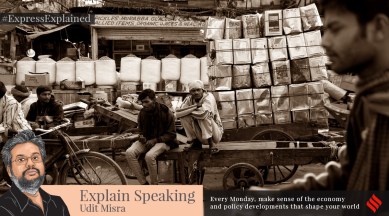Udit Misra is Senior Associate Editor. Follow him on Twitter @ieuditmisra ... Read More

ExplainSpeaking-Economy is a weekly newsletter by Udit Misra, delivered in your inbox every Monday morning. Click here to subscribe
Dear Readers,
As things stand, it now looks quite likely that India’s inflation rate will be above the crucial 4% level in each of the five years of the current government’s term (see Table 1). To be sure, 4% inflation is the target level under the current monetary policy regime.
For one, the January increase was a sharp turnaround from the deceleration in inflation that was being witnessed in the recent months. The headline retail inflation rate was 7.4% in September but since then it was fast losing steam every month and fell to 5.7% in December.
This moderation had convinced many to demand that the RBI should avoid raising interest rates — something the RBI did not do when it met on February 8.
In fact, the RBI raised the repo rate — the interest rate at which it lends money to the banking system — by 25 basis points (100 basis points make up a full percentage point). RBI raises the repo rate when it believes that inflation is not in control. Higher interest rates drag down overall demand for goods and services by making loans costlier. Lower demand is expected to cool down inflation.
The January surge was also an unexpected event — most economists and observers expected inflation to rise by just 6% — and it has renewed the apprehensions of the RBI raising the interest when it meets again in April. RBI’s Monetary Policy Committee (MPC) meets every two months to reconsider its monetary policy stance.
Each passing jump in the interest rate, while doing its bit towards containing inflation, by design also hurts India’s economic growth. To be sure, there is a constant tradeoff between maintaining price stability (read containing inflation) and boosting growth (which hopefully creates jobs and reduces unemployment). In fact, the six-member MPC of the RBI chose to increase the repo rate in February by a split vote of 4-2. The previous review in December also witnessed a hike in repo rate with a split vote of 5-1.
Simply put, if inflation stays persistently high (‘sticky’), it would necessitate the RBI to keep raising interest rates — or, at the very least, keep them at a high level for a longer period — and, in doing so, hurt India’s economic recovery out of the twin shocks of the Covid pandemic and the Russia-Ukraine war.
What caused the spike in January?
There were two main reasons.
One, higher food inflation. In particular, it was the cereal prices that seem to have shot up. Cereals are grains such as wheat and maize. Although, economists at Kotak Institutional Equities — Upasna Bhardwaj, Suvodeep Rakshit and Anurag Balajee — state that there “appears to be some data anomaly in the cereals index for January”. Their calculations suggest that cereal price inflation was far more modest than mentioned in the official release. In their view, it is possible that the final retail inflation rate may fall to 6.2%, instead of 6.5%.
Two, core inflation has inched up. Core inflation is a measure of inflation arrived at by removing the prices of food and fuel. Since food and fuel prices fluctuate massively, often looking at core inflation provides a sense of how the broader economy is doing. Even stricter measures of core inflation such as super core inflation (calculated by Nomura Research) too has gone up in January. Super core inflation is calculated by removing gold and silver price inflation from core inflation. According to Nomura, core inflation rate has inched to 6.2% from 6.1% in December and super core inflation rate has gone up to 6.3% from 6.2% (see Chart 1).
Inflation being sticky essentially means that inflation is taking longer than expected to fall. Essentially, higher food and fuel prices have seeped into the broader economy and made other things costlier.
“A deeper dive into the core inflation basket suggests that firms continued to pass on higher input costs to consumers, while inflation is moderating in the services sector. Core goods inflation continued to inch up to 7.6% y-o-y in January from 7.5% in December and 7.1% six months back. Core services inflation, by contrast, has progressively been moderating from 5.5% in September to 5.0% in January,” the Nomura Research paper written by Sonal Varma and Aurodeep Nandi.
In a paper titled “Anatomy of Inflation’s Ascent in India”, published in December 2022, RBI Deputy Governor Michael Debabrata Patra and others provide a broader explanation:
“What started as a shock to food and fuel prices got increasingly generalised over ensuing months. This was reflected in highly elevated and sticky core inflation. Unprecedented input cost pressures got translated to output prices, particularly goods prices, in spite of muted demand conditions and pricing power. As the direct effects of the conflict waned and international commodity prices softened, the strengthening domestic recovery and rising demand enabled pass-through of pent-up input costs, especially in services, adding persistence to elevated inflationary pressures.” (See Chart 2)
However, for what it is worth, India is not the only country facing sticky inflation; many others — such as the US and countries in the euro zone — are also struggling to extricate themselves from sticky inflation.
Share your views and queries at udit.misra@expressindia.com
Udit